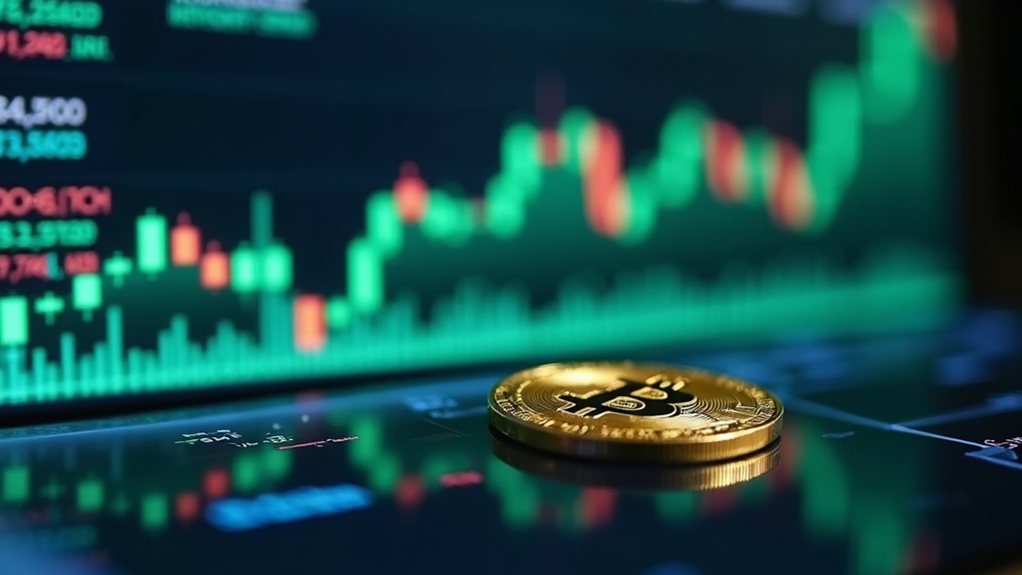Approximately 2.35 million bitcoins (about 11% of total supply) are currently held on cryptocurrency exchanges as of January 2025. This represents a significant decline from early 2020 when exchanges held around 3.1 million BTC. Binance leads with roughly 595,000 BTC, followed by Coinbase with 525,000 BTC. The downward trend indicates investors prefer self-custody and cold storage solutions over keeping assets on centralized platforms. The full picture reveals interesting market dynamics.

Where are all the bitcoins being kept these days? As of January 2025, approximately 2.35 million bitcoins are stored on cryptocurrency exchanges. This represents about II% of the total Bitcoin supply. The number has fallen considerably from early 2020, when exchanges held around 3.1 million BTC. Current levels are the lowest since June 2018, showing a clear trend of users moving their bitcoin away from exchanges.
Among cryptocurrency platforms, Binance leads with roughly 595,000 BTC in its reserves. Coinbase follows closely with about 525,000 BTC. Other major players include Bitfinex with 285,000 BTC, OKX with 240,000 BTC, and Kraken holding approximately 195,000 BTC. These five exchanges account for a substantial portion of all exchange-held bitcoin.
Several factors explain the decline in exchange reserves over recent years. Many users now prefer self-custody solutions, keeping their bitcoin in personal wallets rather than on exchanges. Institutional investors typically move purchased bitcoin to cold storage for security. The launch of Bitcoin ETFs has also led to considerable bitcoin purchases being stored outside traditional exchanges. These centralized exchanges operate as central authorities that maintain control over user funds, which increases security risks compared to self-custody options. Recent data shows BTC exchange reserves have increased by 1% since the start of February, reaching a total of 2.47 million BTC in exchange wallets. Recent data shows Bitcoin exchange reserves have decreased by nearly 121,000 BTC since January 1, representing approximately $10.46 billion leaving centralized platforms. Market sentiment and regulatory changes further influence how much bitcoin stays on exchanges.
The decreasing exchange reserves may impact Bitcoin's price dynamics. Lower reserves can create a supply squeeze in the market, potentially driving up prices due to increased scarcity. This trend often indicates "hodling" behavior, where investors hold their bitcoin rather than preparing to sell. Markets with low exchange reserves tend to experience more volatility, especially during bullish trends, with sharper price movements possible due to reduced liquidity.
Exchange reserve trends have shown a steady decline since the March 2020 market crash. Sharp drops typically coincide with bull market phases, while bear markets sometimes see slight increases as investors prepare to sell. Despite these short-term fluctuations, the long-term trend points clearly downward.
Analysts track these movements through various methods. On-chain analysis examines known exchange wallet addresses, while data providers like Glassnode and CryptoQuant aggregate information. Exchange transparency reports, "whale alert" monitoring of large transfers, and proof of reserves attestations also provide insights into exchange holdings.
The shift of bitcoin away from exchanges suggests broader changes in the cryptocurrency ecosystem. It points to increased decentralization of holdings and growing adoption of non-custodial solutions. Some exchanges may face liquidity challenges if the trend continues. The movement also reflects users' growing emphasis on exchange transparency and a shift toward decentralized finance and peer-to-peer trading options.
Frequently Asked Questions
How Do Exchange Bitcoin Balances Affect Cryptocurrency Prices?
Exchange Bitcoin balances show potential selling pressure in the market. When balances decrease, it typically signals investors are moving coins off exchanges for holding, often driving prices up.
Conversely, rising exchange balances indicate potential selling, which can push prices down. These movements reflect investor sentiment — low balances suggest bullish outlook while high balances point to bearish sentiment.
This relationship creates a notable inverse correlation between exchange balances and cryptocurrency prices.
Which Exchanges Hold the Largest Bitcoin Reserves?
Binance holds the largest Bitcoin reserves among exchanges with over 500,000 BTC, representing about 20% of exchange-held Bitcoin.
Coinbase ranks second with approximately 400,000 BTC (15%), followed by OKX with around 200,000 BTC (8%).
Bitfinex comes fourth, holding about 150,000 BTC (6%).
Binance's reserves have gradually declined since peaking at 600,000+ BTC in 2022, while Coinbase's holdings have remained relatively stable in recent years.
Why Do Bitcoin Holders Withdraw Coins From Exchanges?
Bitcoin holders withdraw coins from exchanges for four main reasons.
They want better security since self-custody prevents hacks and theft.
They're avoiding regulatory concerns that might lead to account freezes.
They're preventing market manipulation by limiting exchanges' ability to use their funds.
Finally, it's a financial strategy that eliminates counterparty risk and enables participation in staking or lending opportunities without paying exchange fees.
How Are Exchange Bitcoin Holdings Verified and Tracked?
Exchange bitcoin holdings are tracked through several methods.
Blockchain analysis tools monitor wallet addresses associated with exchanges.
Self-reported proof of reserves allows exchanges to publish their wallet addresses for verification.
Exchange API data provides balance information that can be aggregated by third parties.
Regulatory disclosures require some exchanges to report their holdings.
Together, these approaches help create transparency, though no single method is completely foolproof.
What Security Measures Do Exchanges Use to Protect Bitcoin Reserves?
Exchanges protect bitcoin reserves through multiple security layers.
They store most bitcoins in "cold storage" – offline systems that hackers can't reach through the internet. Many use multi-signature wallets requiring several approvals for withdrawals.
They encrypt all data and employ two-factor authentication for account access. Regular security audits and insurance policies provide additional protection.
Some exchanges also conduct proof of reserves audits to verify holdings.










